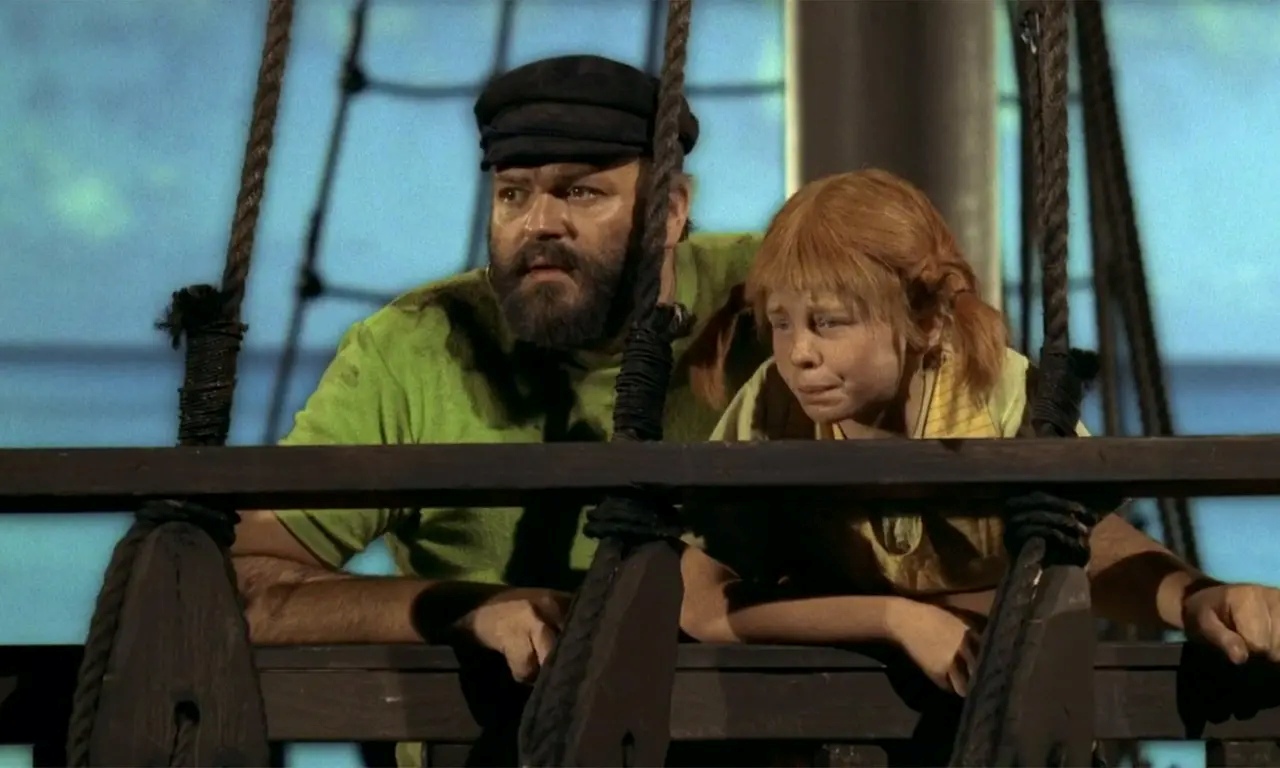(Pippi Långstrump På de Sju Haven)
Crew
Director – Olle Helbom, English Dialogue – Fred Ladd, Producer – Olle Nordemar, Photography – Kalle Bergholm, Music – Georg Riedel, Pippi Theme – Konrad Elfers & Jan Johansson. Production Company – Iduna Film/KB Nord Art AB.
Cast
Inger Nilsson (Pippi Longstocking), Maria Persson (Anneka Settigren), Par Sundberg (Tommy Settigren), Beppe Wolgren (Captain Ephriam Longstocking), Alfred Schieske, Wolfgang Volz, Nickolaus Schilding, Martin Ljung, Jarl Sorsen
Plot
Tommy and Anneka Settigren’s parents go away on holiday, leaving them behind in the charge of Pippi Longstocking. While they are playing, Pippi finds a message in a bottle from her father, saying that he has been captured by his ship’s crew and is being kept prisoner until he tells them where his treasure is. With Tommy and Anneka in tow, Pippi sets out to the South Seas to rescue her father, travelling aboard a bed attached to balloons, a homemade plane and a stolen pirate ship. There Pippi must first rescue her father and then race his mutinous pirate crew to the treasure.
Pippi in the South Seas was the third of the Swedish-made Pippi Longstocking films based on Astrid Lindgren’s immensely popular children’s books. The film series had begun with Pippi Longstocking (1969), which was made concurrent with a tv series Pippi Longstocking (1969). Pippi in the South Seas is loosely based on the third of Astrid Lindgren’s Pippi books Pippi in the South Seas (1948). The other films in the series, the second and fourth respectively, were Pippi Goes on Board (1970) and Pippi on the Run (1973).
Pippi in the South Seas survives somewhat more likeably than the other Swedish Pippi films due to its approximating the absurdist nonsense of Astrid Lindgren’s books – the other films tended to bog down in dull and prosaic adventures running around the backyard of the Villa Villekula and so on. By contrast, Pippi in the South Seas leaps off into full-fledged fantasy with bizarre flying machines, including a ride aboard a ramshackle contraption consisting of bedsteads attached to hot-air balloons, which does capture some of the absurdism of the books. There is some entertaining nonsense in the middle of the film with Pippi using her super-strength to defeat a crew of pirates single-handedly – at one point blowing them all across a tavern. Inger Nilsson has a pirate song that she gets to deliver in the midst of a storm, which is particularly memorable.

As usual with these Pippi films, Pippi in the South Seas has a glaringly threadbare tattiness to it. The water tanks and ship models are especially shabby. The locations hardly look like the South Seas or the Caribbean. The lack of budget is notably evident in the diving scenes, which have merely thrown together stock underwater film footage in lieu of actually showing the cast (or even any people) beneath the water.
These Pippi Longstocking films also do not exactly encourage responsible parenting – something that is at its most extreme here where two parents seem happy to go away for a holiday and leave their two children in the care of another child the same age who promptly takes them out of the country and into highly hazardous conditions (fighting pirates, into taverns and aboard highly unstable flying machines).
Trailer here


